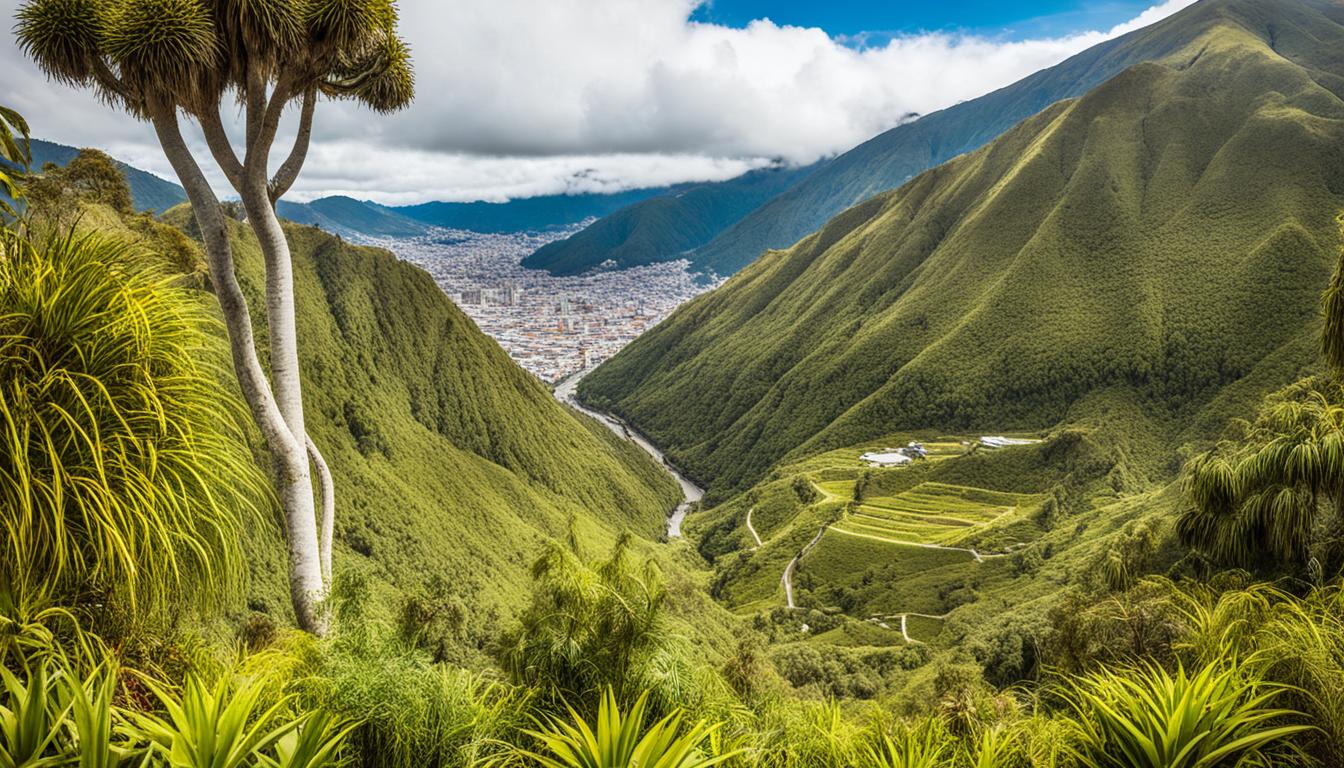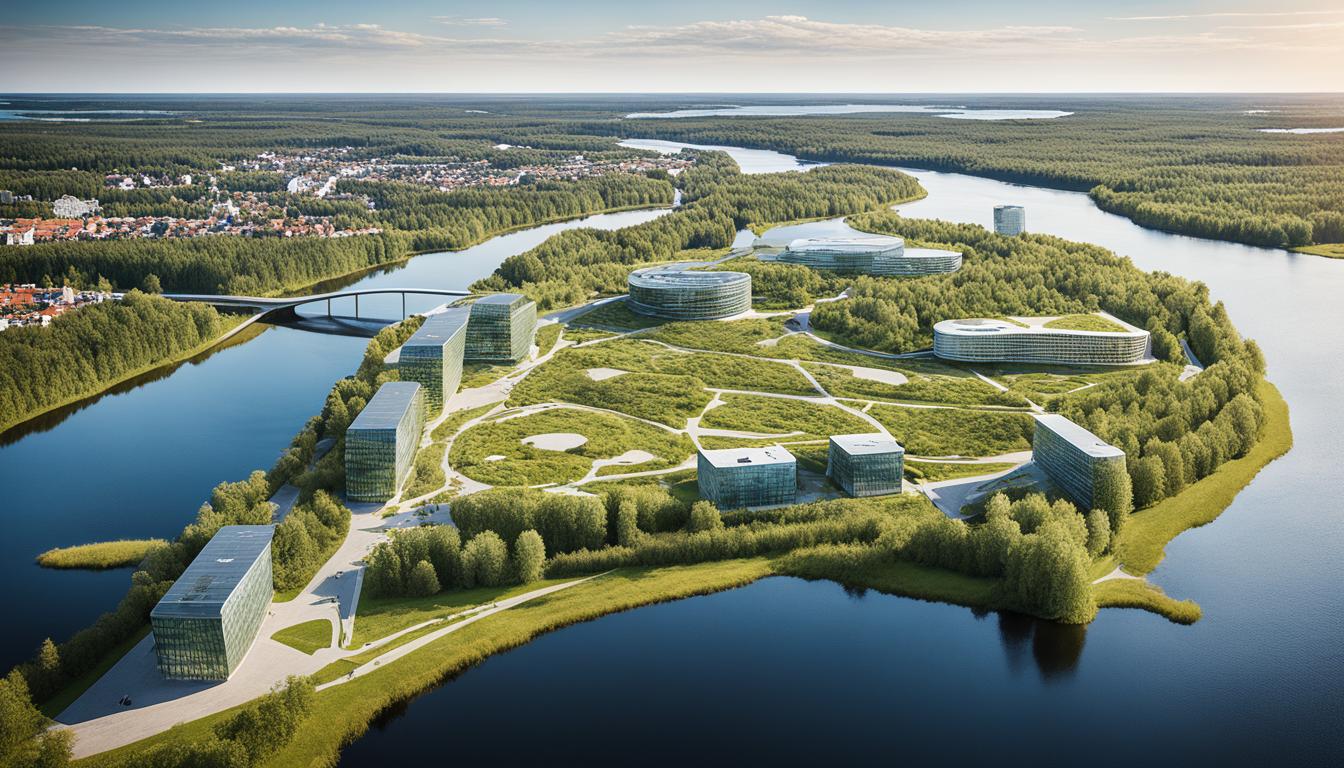Egypt Biodiversity and the Built Environment
Did you know that Egypt is home to over 10,000 plant and animal species?
When we think of Egypt, majestic pyramids and the ancient civilization of the Pharaohs often come to mind. However, this culturally rich country is also teeming with diverse ecosystems and remarkable biodiversity. From the stunning coral reefs of the Red Sea to the lush oases in the Western Desert, Egypt’s natural landscapes are truly awe-inspiring.
But as Egypt continues to experience rapid urbanization and development, the preservation of its biodiversity faces significant challenges. The delicate balance between sustainable development and ecosystem preservation must be carefully considered in urban planning and construction initiatives.
In this article, we will explore the efforts being made to protect Egypt’s biodiversity in the face of urban expansion. From environmental impact assessments to the implementation of green infrastructure, we will delve into the strategies being employed to ensure the ecological equilibrium is maintained. Join us on this journey to learn how the built environment can coexist harmoniously with Egypt’s precious natural heritage.
Key Takeaways:
- Egypt is home to over 10,000 plant and animal species, highlighting its incredible biodiversity.
- The preservation of Egypt’s biodiversity faces challenges due to rapid urbanization and development.
- Strategies such as environmental impact assessment and green infrastructure are being implemented to protect Egypt’s biodiversity.
- The built environment can coexist harmoniously with Egypt’s natural heritage through proactive measures.
- Preserving Egypt’s biodiversity is crucial for sustainable development and the well-being of future generations.
Overview of Egypt’s Environmental Challenges
Egypt, with its arid climate and heavy reliance on the Nile River, faces several significant environmental challenges. These challenges are exacerbated by factors such as population growth, water scarcity, and the exploitation of natural resources. Let’s explore these challenges in detail.
The Arid Climate and Nile River
Egypt’s arid climate poses a significant obstacle to sustainable development. With limited rainfall and a considerable proportion of the country covered by desert, water scarcity is a constant concern. However, Egypt has long relied on the Nile River to support its agriculture and freshwater needs. The Nile serves as a crucial lifeline for the country, but increasing demand and the impacts of climate change pose significant threats to this vital resource.
Population Growth and Water Scarcity
The rapid population growth in Egypt further strains the available water resources. A growing population means increased water demand for drinking, agriculture, and industry. As the population continues to expand, the pressure on water sources intensifies, exacerbating water scarcity issues. Without effective solutions, this water scarcity threatens food security, economic stability, and the well-being of the population.
“Water scarcity and population growth are pressing challenges in Egypt. The country must strategically manage its water resources to meet the needs of its growing population and ensure a sustainable future.” – Water Conservation Authority
Reclaiming Desert Land and its Effects
To accommodate population growth and optimize land use, Egypt has undertaken ambitious projects to reclaim desert land for agriculture and urban development. While these efforts aim to utilize untapped resources, they create additional demands for water. The process of reclaiming desert land involves water-intensive techniques, potentially exacerbating water scarcity issues in the long run.
Projected Pace of Urbanization and its Impact
Egypt is experiencing rapid urbanization with the growth of megacities and urban areas. This pace of urbanization places further strain on resource systems, including water supply, infrastructure, energy, and waste management. The challenge lies in ensuring the sustainable management of resources and infrastructure, while providing adequate services and maintaining environmental balance.
Vulnerability of Coastal Areas
Coastal areas in Egypt are particularly vulnerable to the impacts of climate change, including sea-level rise and land subsidence. These areas face increased risks of flooding and erosion, threatening both human settlements and valuable ecosystems. Protecting and adapting these coastal zones is crucial for minimizing the potential damage and ensuring the sustainability of coastal communities.
Economic Conditions and the Agricultural Sector
The agricultural sector plays a crucial role in Egypt’s economy, providing employment for a significant portion of the population. Agriculture also contributes to food security, as it ensures a stable supply of essential commodities. However, the sector faces challenges that threaten its sustainability, such as climate-related disruptions and economic dependence on imported wheat. These issues have implications not only for the agricultural sector but also for tourism and overall economic stability.
Wheat cultivation is a vital component of Egypt’s agricultural sector. The country relies heavily on wheat imports to meet domestic demand, making it vulnerable to fluctuations in international prices and supply disruptions. This reliance on imports poses risks to food security, as it exposes the country to potential shortages and price hikes. Ensuring a reliable and sustainable domestic wheat production is essential to address food insecurity and reduce economic dependence on imports.
“Sustaining a robust agricultural sector is crucial for Egypt’s food security and overall economic stability. Investing in domestic wheat production and reducing dependence on imports should be a priority to address these challenges,” said Dr. Ahmed Hassan, an agricultural economist.
In addition to agriculture, tourism plays a significant role in Egypt’s economy. The country’s rich history, cultural heritage, and natural attractions attract millions of tourists each year, contributing to employment and revenue generation. However, the vulnerability of the agricultural sector to climate-related disruptions, such as droughts and extreme temperatures, can have adverse effects on tourism as well. Environmental degradation and ecosystem imbalances resulting from these disruptions can negatively impact Egypt’s natural attractions, leading to a decline in tourist arrivals.
Efforts to overcome these challenges require significant investments in climate mitigation and adaptation measures. However, financing such initiatives can be a challenge. The agricultural sector, which is the backbone of Egypt’s economy, requires financial resources to adapt to changing climatic conditions, improve irrigation systems, and implement sustainable farming practices.
| Challenges | Potential Solutions |
|---|---|
| Reliance on imported wheat | Diversification of crops and increased investment in domestic wheat production |
| Climate-related disruptions | Investment in climate-smart agriculture and irrigation systems for sustainable farming |
| Financing climate mitigation and adaptation | Public and private sector collaborations, international funding, and innovative financial mechanisms |
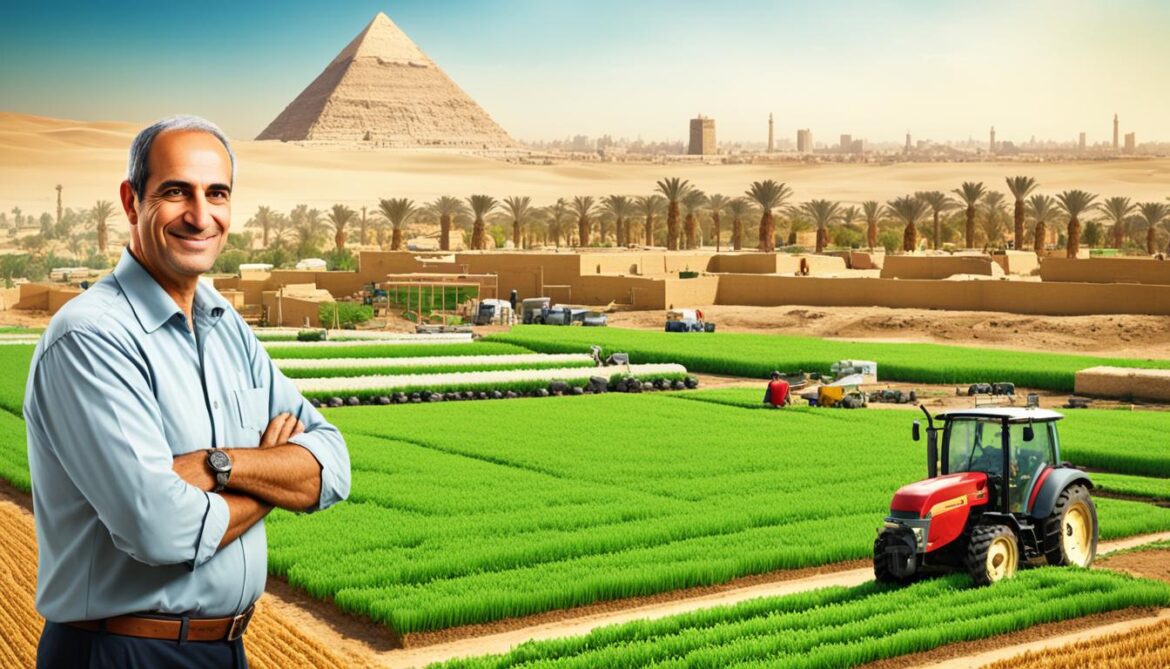
The Impacts of Climate Change on Egypt’s Agricultural Sector
Climate change poses significant risks to Egypt’s agricultural sector, threatening food security and economic stability. Rising temperatures, irregular precipitation patterns, and increased frequency of extreme weather events disrupt agricultural production and compromise the livelihoods of farmers.
Higher temperatures reduce crop yields and increase the risk of pests and diseases. Moreover, erratic rainfall patterns and prolonged droughts affect water availability for irrigation, leading to crop failures and water scarcity. These climate-related challenges require urgent attention and concerted efforts to develop resilience strategies and adapt to changing climatic conditions.
Investments in climate-smart agriculture techniques, such as precision farming, water-efficient irrigation systems, and improved crop varieties, can help mitigate the impacts of climate change on the agricultural sector. Additionally, strengthening agricultural extension services and knowledge sharing among farmers can facilitate the adoption of sustainable practices and enhance resilience in the face of climate-related challenges.
The Role of Government Policies and International Cooperation
The Egyptian government plays a crucial role in addressing the challenges faced by the agricultural sector and ensuring its long-term sustainability. Policies that promote sustainable agriculture, support farmers with access to finance and technical assistance, and encourage research and development in agriculture are essential in enhancing the sector’s resilience to climate change.
Furthermore, international cooperation and partnerships can provide additional support and resources to address the challenges faced by Egypt’s agricultural sector. Collaboration with international organizations, research institutions, and other countries can facilitate knowledge exchange, technology transfer, and capacity-building initiatives to enhance agricultural productivity, promote sustainable practices, and mitigate climate change impacts.
Climate Change Impacts – Extreme Temperatures, Irregular Precipitation, and Drought
The rising temperatures in Egypt have become a growing concern in recent years, with an accelerated rate of temperature rise observed. This increase in temperature is a direct result of climate change, which has far-reaching consequences for the country.
One of the major impacts of climate change in Egypt is the disruption of rainfall patterns. Irregular precipitation has become more common, leading to unpredictable weather events and challenges for agricultural practices that depend on consistent rainfall. This variability in precipitation can have severe implications for crop production and food security.
According to climate projections, Egypt’s average annual temperature is predicted to increase significantly by 2050 and 2100. This rise in temperature will further exacerbate the challenges faced by the country, including increased water scarcity and drought conditions. With higher temperatures, water demand will increase, putting additional pressure on already limited water resources. Droughts are expected to become more frequent and intense, further straining the agricultural sector and the overall economy.
Addressing the impacts of climate change, such as extreme temperatures, irregular precipitation, and drought, requires urgent action and effective mitigation and adaptation strategies. It is crucial for Egypt to invest in sustainable practices and policies that reduce greenhouse gas emissions, promote water efficiency, and enhance resilience to climate-related challenges.
Climate change is a global issue that requires collective effort and immediate action. The consequences of inaction are severe, and it is up to all of us to prioritize sustainability and protect our planet.
Impact of Climate Change on Egypt’s Key Sectors
Climate change has wide-ranging effects on various sectors in Egypt. Here is an overview of the impacts on key sectors:
| Sector | Impact of Climate Change |
|---|---|
| Agriculture | Decreased crop yields due to water scarcity and irregular precipitation patterns. |
| Water Resources | Increased stress on water sources, leading to water scarcity and higher demand for irrigation. |
| Tourism | Disruption of coastal ecosystems, increased frequency of extreme weather events, and loss of biodiversity affect Egypt’s tourism industry. |
| Health | Rising temperatures increase the risk of heat-related illnesses and the spread of vector-borne diseases. |
| Infrastructure | Increased vulnerability to extreme weather events, such as flooding and sea-level rise, affecting coastal areas and urban centers. |

As the effects of climate change become more pronounced, it is crucial for Egypt to prioritize sustainable development and implement measures to mitigate and adapt to these changes. By investing in renewable energy, sustainable agriculture practices, water conservation, and ecosystem conservation, Egypt can build resilience and reduce the adverse impacts of climate change on its economy and society.
Introduction to Biodiversity and Its Importance
Biodiversity is the intricate web of life that encompasses all living organisms and their interactions within ecosystems. It is a fundamental component of the natural environment, indispensable for the functioning of our planet’s ecosystems, and essential for the survival and well-being of both wildlife and humans.
Beyond its intrinsic value, biodiversity holds significant economic value as well. It underpins various industries, including agriculture and tourism, which are crucial for many countries’ economies. Biodiversity fuels agricultural productivity by supporting pollination, pest control, and soil fertility. Additionally, diverse ecosystems attract tourists, contributing to local economies and job creation.
Biodiversity provides a wide range of ecosystem services, which are the benefits that ecosystems offer to human societies. These services include clean air and water, climate regulation, soil stabilization, and natural disaster mitigation. Biodiversity also plays a vital role in regulating ecological balance, ensuring the stability and resilience of ecosystems in the face of environmental changes.
However, biodiversity is currently facing numerous threats, including habitat loss and climate change. The destruction and fragmentation of natural habitats due to human activities, such as deforestation and urbanization, are causing the loss of biodiversity at an alarming rate. These impacts disrupt the delicate balance of ecosystems, leading to biodiversity decline and potential ecological consequences.
Hence, it is crucial to recognize the value and importance of biodiversity and take proactive measures to protect and conserve it. By preserving biodiversity, we preserve the intricate web of life and ensure the continued provision of vital ecosystem services essential for both the environment and our own well-being.
Biodiversity Loss in Egypt
Egypt is currently facing significant challenges in preserving its biodiversity. The decline of biodiversity is evident at various levels, including ecosystems, species, and populations.
The ecological pressures contributing to this decline are multifaceted. Habitat loss, caused by human activities such as urbanization and deforestation, is a major factor. Additionally, resource exploitation, pollution, the introduction of invasive species, and the impacts of climate change are all contributing to the loss of biodiversity.
One of the significant drivers of biodiversity loss in Egypt is habitat loss. As urbanization expands and forests are cleared to make way for agriculture and infrastructure, the natural habitats of many species are being destroyed. This loss of habitat disrupts the delicate balance of ecosystems and threatens the survival of various species.
Pollution also plays a role in biodiversity decline. Industrial pollution, agricultural runoff, and improper waste management contaminate water sources and negatively impact aquatic life. Similarly, air pollution from vehicle emissions and industrial activities harms both plants and animals.
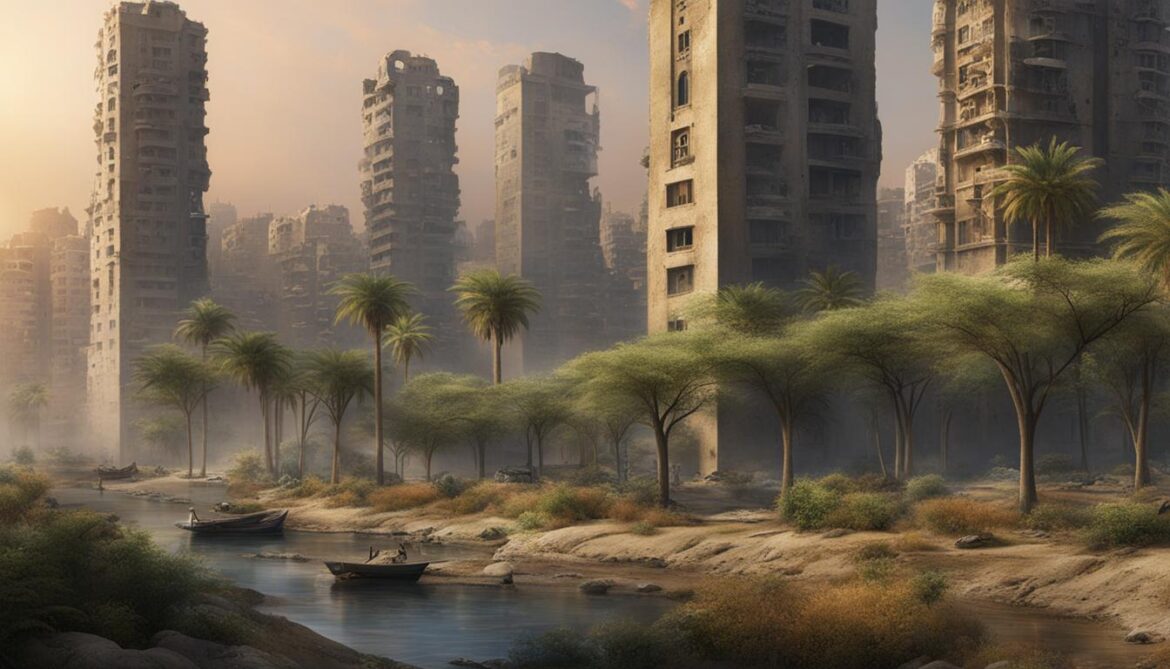
Climate change is another significant driver of biodiversity loss in Egypt. Rising temperatures, changing rainfall patterns, and increased frequency of extreme weather events are disrupting ecosystems and putting stress on species. Some species are unable to adapt to these changes, leading to population decline or even extinction.
Moreover, population growth and associated constraints are exacerbating biodiversity loss in Egypt. The increasing demands for resources, infrastructure development, and food production put additional pressure on already vulnerable ecosystems.
In order to address the challenge of biodiversity loss, it is crucial to implement effective conservation measures. Protecting and restoring natural habitats, reducing pollution, and taking steps to mitigate the impacts of climate change are essential. Additionally, sustainable resource management and population control measures should be considered to alleviate the pressures on biodiversity.
Biodiversity Net Gain and the Construction Industry
The construction industry plays a significant role in shaping our built environment. However, the development and expansion of urban areas can have detrimental effects on biodiversity. In response to this challenge, the concept of biodiversity net gain has emerged as a promising approach to mitigate the environmental impact of construction projects.
Biodiversity net gain refers to the practice of enhancing and increasing biodiversity as a result of new development or land use change. It involves measures such as habitat creation, restoration, and enhancement, which aim to offset any biodiversity loss that may occur due to construction activities.
Recognizing the importance of preserving and enhancing biodiversity, governments and regulatory bodies around the world have proposed regulations mandating biodiversity net gain in new construction developments. These regulations make it compulsory for developers to demonstrate that their projects will have a positive impact on biodiversity.
The potential impact of biodiversity net gain on habitat preservation and green spaces in urban areas is significant. By incorporating green infrastructure, such as parks, gardens, and green roofs, into construction projects, developers can create ecological corridors and provide habitat for native wildlife species.
Moreover, green spaces in urban areas offer numerous benefits to both humans and the environment. They improve air quality, reduce urban heat island effects, and provide recreational spaces for communities. Therefore, integrating green spaces into construction projects not only promotes biodiversity but also enhances the quality of life in urban environments.
“Biodiversity net gain in the construction industry is a win-win situation. It allows for sustainable development while ensuring the preservation and enhancement of our natural environment.”
The Global Targets for Biodiversity Conservation and Restoration
The importance of biodiversity conservation and restoration is now recognized on a global scale. The Convention on Biological Diversity (CBD) and its upcoming COP15 conference have set ambitious targets for the conservation and restoration of ecosystems.
One of the key targets proposed by the CBD is to conserve at least 30% of land and sea areas by 2030. This target aims to protect critical habitats and ensure the long-term survival of species. By implementing biodiversity net gain in the construction industry, a significant contribution can be made towards achieving this target.
Additionally, the CBD’s Global Biodiversity Outlook emphasizes the need to mainstream biodiversity conservation and restoration into all sectors, including the built environment. This highlights the crucial role that the construction industry can play in preserving and enhancing biodiversity.
Benefits of Biodiversity Net Gain in the Construction Industry
| Benefits | Description |
|---|---|
| Preservation of Natural Habitats | Protection and enhancement of existing habitats, ensuring the survival of native species. |
| Creation of Green Spaces | Integration of parks, gardens, and green roofs into construction projects to enhance urban greenery and improve the quality of life. |
| Wildlife Conservation | Supporting the survival of native wildlife species by providing suitable habitats and ecological corridors. |
| Ecosystem Services | Enhancement of ecosystem services, such as pollination and nutrient cycling, which are essential for human well-being. |
| Sustainable Development | Balancing economic development with environmental protection, creating a more sustainable future. |

Implementing biodiversity net gain in the construction industry is an opportunity to achieve sustainable development while preserving and enhancing our natural environment. By prioritizing habitat modification and incorporating green spaces into construction projects, we can create a built environment that supports biodiversity and benefits both ecosystems and communities.
Practical Approaches to Promoting Biodiversity in the Built Environment
Creating green spaces in urban areas is essential for promoting biodiversity and enhancing the natural environment. Public parks, green walls, and green roofs play a significant role in providing habitat for various species and improving ecological balance.
In addition to establishing green spaces, habitat modification within buildings can contribute to wildlife refuge. By utilizing existing space and incorporating elements such as nesting boxes and artificial structures, we can create safe havens for birds, insects, and other wildlife.
Implementing specific planting regimes, both indoors and outdoors, can also support biodiversity in the built environment. Strategically selected native plants help attract and sustain local flora and fauna, contributing to a well-balanced ecosystem. These planting regimes can be designed to provide food and shelter for different species throughout the year.
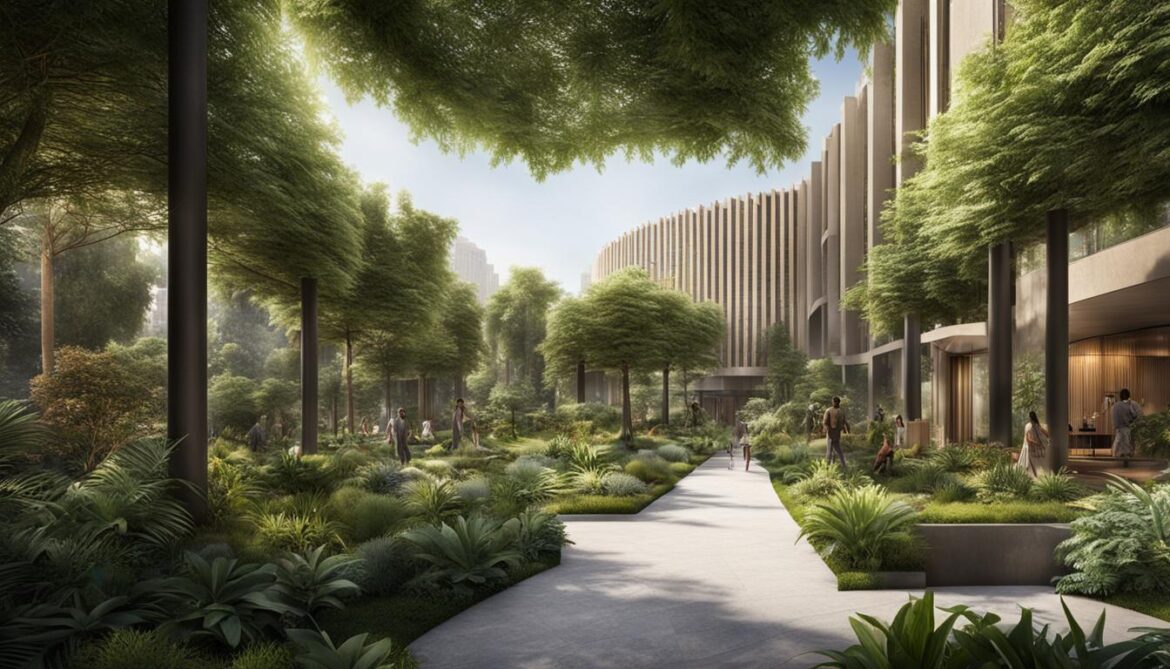
Beehive installations are another practical approach to promoting biodiversity, especially in urban areas. Bees play a crucial role in pollination, benefiting not only the natural environment but also agricultural productivity. By providing suitable habitats for bees, we can help address the decline of pollinators and ensure the continuation of essential ecosystem services.
Collecting biodiversity data is vital for understanding the effectiveness of these approaches and making informed decisions. By regularly monitoring and reporting biodiversity data to authorities, we can assess the success of conservation efforts and identify areas for improvement. This data-driven approach allows us to adapt and refine strategies for better outcomes.
In conclusion, incorporating green spaces, habitat modification, planting regimes, and biodiversity data collection are practical steps we can take to promote biodiversity in the built environment. These initiatives not only enhance the natural environment but also contribute to the overall well-being of communities, creating sustainable and vibrant urban spaces for generations to come.
Partnership and Initiatives for Biodiversity Conservation
Collaboration between corporations and conservation organizations plays a crucial role in biodiversity conservation efforts in the built environment. One notable example is the partnership between Mace, a global construction company, and the Lancashire Wildlife Trust.
Mace’s collaboration with the Lancashire Wildlife Trust demonstrates their commitment to restoring habitats for endangered and rare species. Through this partnership, they aim to mitigate the impact of construction projects on biodiversity and contribute to overall conservation goals.
Nature-based solutions are another key approach to biodiversity conservation. These solutions involve incorporating elements of nature into the built environment to restore ecosystems and enhance habitat diversity. They not only contribute to the preservation of endangered species but also provide a range of additional benefits, such as enhancing urban aesthetics, improving air quality, and mitigating the urban heat island effect.
“Nature-based solutions have immense potential in promoting biodiversity conservation in urban areas. By integrating green infrastructure, such as green roofs, urban parks, and green walls, we can create suitable habitats for various species and protect biodiversity within the built environment.”
In addition to supporting endangered species and enhancing biodiversity, these nature-based solutions also contribute to carbon sequestration and climate change mitigation. They play a vital role in restoring ecosystems that can effectively absorb and store carbon dioxide, thereby helping to combat climate change.
Successful partnerships and initiatives for biodiversity conservation are vital in creating a sustainable future for both the built and natural environments. By implementing corporate partnerships, restoration projects, and nature-based solutions, we can protect our precious biodiversity and ensure a healthier planet for future generations.
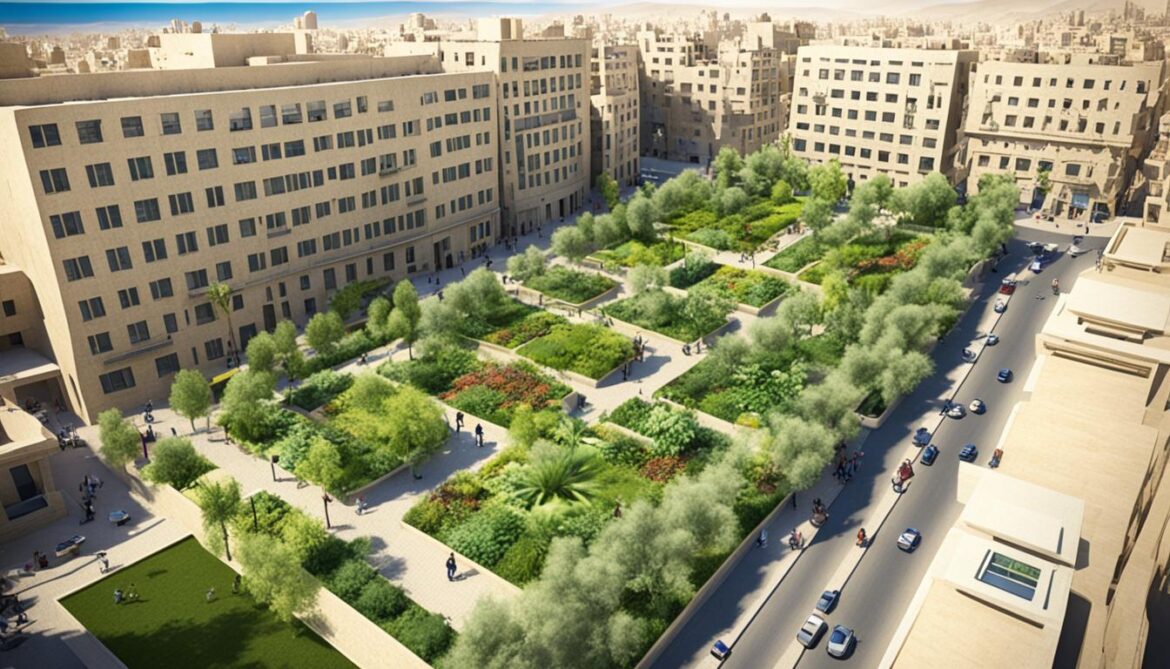
Biodiversity and the Future of the Built Environment
The upcoming UN Biodiversity Conference, also known as COP15, holds significant importance in shaping the future of biodiversity conservation. This global gathering will set the stage for collaborative efforts towards the conservation and restoration of land and marine areas.
One of the key outcomes expected from COP15 is the establishment of ambitious targets for biodiversity conservation. These targets will serve as a roadmap for action and provide clear guidelines for governments, businesses, and individuals to contribute to the protection and enhancement of biodiversity.
Businesses, in particular, will have a critical role to play in this global endeavor. They will be required to assess and report on their biodiversity impacts and dependencies as part of their corporate responsibility. By incorporating biodiversity considerations into their operations, businesses can actively contribute to biodiversity conservation and help meet the proposed targets.
The built environment, including construction and infrastructure development, can become leaders in biodiversity protection and enhancement. Through sustainable building practices, green infrastructure, and habitat restoration, the built environment can provide valuable spaces for biodiversity to thrive and promote ecological balance in urban areas.

Building Commissioning and Biodiversity
Building commissioning, the process of ensuring that a building performs according to the intended design and operational requirements, can have a significant impact on biodiversity conservation. By integrating biodiversity considerations into the design and construction phases, buildings can minimize their ecological footprint and provide habitats for various species.
| Benefits of Biodiversity-Inclusive Building Commissioning | Examples |
|---|---|
| Enhanced ecosystem services | Incorporating green roofs and walls to support urban biodiversity and improve air quality. |
| Promotion of biodiversity corridors | Designing buildings and landscapes to create interconnected habitats for wildlife movement. |
| Resilience to climate change | Using native plants in landscaping to adapt to changing climatic conditions. |
| Improved human well-being | Access to green spaces and natural environments positively impacts mental and physical health. |
By embracing biodiversity-inclusive building commissioning practices, the construction industry can contribute to the global efforts towards biodiversity conservation and the achievement of COP15 targets. Through collaboration, innovation, and the integration of biodiversity considerations, the future of the built environment can be one that harmoniously coexists with nature.
Conclusion
Biodiversity plays a crucial role in the built environment, not only for the preservation of the natural environment but also for the well-being of society as a whole. It is important to raise awareness among industry stakeholders about the significance of biodiversity and incentivize initiatives that promote its conservation. By doing so, the construction industry has the opportunity to become a leader in biodiversity protection and create a sustainable future.
The built environment has a direct impact on biodiversity, as it can contribute to habitat loss and the degradation of ecosystems. However, with the right strategies and practices, it can also serve as a platform for biodiversity conservation. By incorporating green spaces, promoting habitat modification, and implementing planting regimes, the built environment can provide a refuge for wildlife and contribute to the overall enhancement of biodiversity.
Creating awareness about the importance of biodiversity in the built environment is key to driving change. Industry stakeholders, including developers, architects, and policymakers, need to be educated about the value of biodiversity and its role in creating resilient and livable cities. Furthermore, incentivizing biodiversity initiatives through government policies, tax incentives, and certification programs can encourage businesses to prioritize biodiversity conservation in their projects.
In conclusion, the preservation and promotion of biodiversity in the built environment is a shared responsibility that requires a collaborative effort. By raising awareness, providing incentives, and implementing sustainable practices, we can ensure the coexistence of thriving ecosystems and human development. The construction industry has the potential to make a significant impact and lead the way towards a greener and more biodiverse future.
FAQ
What is the importance of biodiversity in the built environment?
Biodiversity plays a crucial role in maintaining the natural environment and supporting sustainable development. It provides essential ecosystem services, such as pollination, nutrient cycling, and water purification. Biodiversity also contributes to the economic value of agriculture and tourism, ensuring the well-being of both the natural environment and human society.
What are the main threats to biodiversity in Egypt?
Egypt faces various challenges to biodiversity conservation, including habitat loss, pollution, invasive species, resource exploitation, and climate change. These factors contribute to the decline of ecosystems, species, and populations, putting Egypt’s valuable biodiversity at risk.
How can the construction industry promote biodiversity conservation?
The construction industry can make a positive impact on biodiversity by implementing biodiversity net gain measures. This includes habitat modification and the creation of green spaces, such as public parks, green walls, and green roofs. By incorporating wildlife-friendly features into buildings and adopting sustainable practices, the industry can contribute to preserving and enhancing biodiversity.
What practical approaches can be taken to promote biodiversity in the built environment?
Practical approaches include implementing indoor and outdoor planting regimes, creating wildlife-friendly areas within buildings, and installing beehives to support pollinators. Collecting biodiversity data and reporting to authorities is also important for monitoring and managing biodiversity in the built environment.
Are there any partnerships and initiatives for biodiversity conservation in the built environment?
Yes, there are various partnerships and initiatives focusing on biodiversity conservation. For example, Mace has partnered with the Lancashire Wildlife Trust to restore habitats for endangered and rare species. Nature-based solutions are also being explored to enhance biodiversity in the built environment.
How does biodiversity conservation relate to the future of the built environment?
The upcoming UN Biodiversity Conference (COP15) will play a significant role in shaping the future of biodiversity conservation. Targets for the conservation and restoration of land and marine areas are being proposed. The built environment has a responsibility to assess and report their biodiversity impacts and dependencies, becoming leaders in biodiversity protection and enhancement.
Why is raising awareness and incentivizing biodiversity initiatives important?
Raising awareness among industry stakeholders about the importance of biodiversity in the built environment is crucial. By educating and incentivizing companies to prioritize biodiversity initiatives, we can encourage the construction industry to become more sustainable and contribute to the protection and enhancement of biodiversity for a better future.



